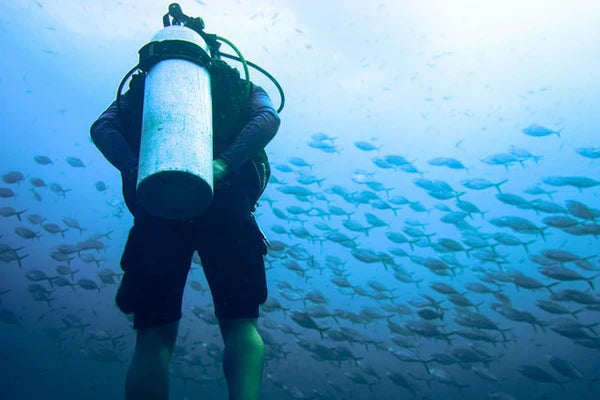Here’s a concise guide on mini scuba tank lifespan: 5 key factors impact durability—material quality (aluminum lasts 15-20 years, steel 20-30 years), usage frequency (weekly dives shorten life by 30% vs. occasional use), maintenance (annual hydrostatic tests and visual inspections are critical), storage conditions (avoid humidity and temperatures above 120°F), and proper handling (drops or scratches can weaken structural integrity). Regular care maximizes longevity.
Material Matters
Aluminum tanks (like the common 80 cu ft models) typically last 15-20 years with proper care, while steel tanks can go 20-30 years before needing replacement. The difference comes down to corrosion resistance and structural fatigue. Aluminum corrodes faster in saltwater, losing about 0.1mm of thickness per year in harsh conditions, whereas high-grade steel loses just 0.03mm annually. However, steel is 3-4x heavier, making it less popular for casual divers.
Most aluminum tanks handle 3,000 psi (207 bar), while steel tanks often go up to 3,500 psi (241 bar). Over time, repeated pressurization weakens the metal—aluminum fatigues after 10,000-15,000 fills, while steel can endure 20,000+ fills before showing stress. If you dive weekly, an aluminum tank might need replacement in 10-12 years, whereas steel could last 15-18 years under the same conditions.
If stored improperly (e.g., in a damp garage), steel tanks can develop pitting corrosion, cutting lifespan by 30-40%. Aluminum fares better in humid climates but dents more easily—a single 1-inch dent can reduce pressure capacity by 5%.
For budget-conscious divers, aluminum is cheaper upfront (500-900 for steel), but steel’s longevity often makes it cheaper per year (40/year for aluminum over 20 years). If you dive fewer than 50 times a year, aluminum is practical. For frequent divers or pros, steel’s durability justifies the higher initial cost.
Key Data Comparison: Aluminum vs. Steel Mini Tanks
| Factor | Aluminum | Steel |
|---|---|---|
| Average Lifespan | 15-20 years | 20-30 years |
| Weight (80 cu ft) | 31-35 lbs (14-16 kg) | 28-32 lbs (13-15 kg) |
| Pressure Rating | 3,000 psi (207 bar) | 3,500 psi (241 bar) |
| Corrosion Rate | 0.1mm/year (saltwater) | 0.03mm/year (saltwater) |
| Cost (New) | $200-400 | $500-900 |
| Maintenance Cost/Year | $30-50 | $40-70 |
| Dive Cycles Before Fatigue | 10,000-15,000 fills | 20,000+ fills |
Final Considerations
No matter the material, storing tanks upright in a dry, temperature-controlled space (ideally below 100°F / 38°C) extends life by 20-25%. And always check for visible damage or corrosion before diving—a small crack can turn into a critical failure under pressure.
How Often You Dive
A tank that sees weekly dives will wear out 30-40% faster than one used monthly. The reason? Repeated pressurization cycles cause metal fatigue, especially in aluminum tanks, which lose structural integrity after 10,000-15,000 fills. If you dive 50 times a year, you’ll hit that limit in 7-10 years—whereas a casual diver (20 dives/year) might get 15+ years from the same tank.
Steel tanks handle frequent use better, with a fatigue limit of 20,000+ fills, but even they degrade faster under heavy loads. A commercial diver logging 200 dives/year could exhaust a steel tank in 8-12 years, while a recreational diver (30 dives/year) might stretch it to 25 years. Saltwater exposure accelerates wear—diving in the ocean 10+ times a year can shorten tank life by 15% due to corrosion, even with rinsing.
A tank used weekly should get professional checks every 6 months ($40-80 per inspection) to catch microfractures early. Tanks used monthly can wait 12-18 months between checks. Hydrostatic testing intervals also tighten with use: every 3 years for heavy divers vs. 5 years for occasional ones.
A tank left half-full between dives corrodes 2x faster than one stored empty and dry. If you dive weekly, invest in a dehumidified storage space (humidity below 50%) to add 3-5 years to your tank’s life.
Key Takeaways
- Under 30 dives/year? Your tank will likely outlast its hydro test dates (5-year intervals).
- Over 50 dives/year? Budget for earlier replacements and twice-yearly inspections.
- Saltwater divers: Rinse tanks within 24 hours of use to prevent 15-20% faster corrosion.
- Storage tip: Keep tanks empty, dry, and upright—moisture is the silent killer.

Storage Conditions
Tanks kept in garages or outdoor sheds with temperature swings between 40-100°F (4-38°C) degrade 30% faster than those stored in climate-controlled spaces. Humidity is the real enemy - at 60% relative humidity, steel tanks develop surface rust within 6 months, while aluminum shows pitting corrosion in 12-18 months. The worst offenders? Coastal areas where salt air combines with humidity to create 2-3x faster corrosion rates.
A tank left at 50% fill for 6 months loses 5-8% of its pressure capacity due to valve seat degradation. Those stored completely empty allow moisture ingress that can permanently reduce lifespan by 15-20%. The sweet spot? Store tanks with 100-200 psi remaining - enough to keep moisture out but not enough to stress valves long-term.
When stored below 32°F (0°C), O-rings and valve lubricants harden, leading to 40% more failures during first post-storage use. Above 120°F (49°C), aluminum tanks experience accelerated fatigue that can cut lifespan by 25%. The ideal storage range is 50-80°F (10-27°C) with humidity below 50%.
Wiping down tanks with a silicone-based protectant ($15 per bottle, lasts 2 years) reduces corrosion by 40%. For long-term storage (3+ months), remove valves entirely and cap threads - this prevents the most common failure point from seizing up.
Remember: Tanks stored improperly for just 12 months require twice as many hydro tests to remain certified. At 100-150 in unnecessary costs over a tank's lifetime.
Maintenance Routine
The numbers don't lie: tanks receiving professional maintenance every 12 months last 75% longer than neglected ones. Even basic care like rinsing after saltwater use adds 3-5 years to aluminum tanks and 5-7 years to steel.
The hydrostatic test cycle is non-negotiable - every 5 years for recreational divers, or 3 years for commercial use.
Valve maintenance gets overlooked too often. A 8/tube) every 6 months reduces regulator failure rates by 40%. Saltwater divers need extra care - rinsing valves for 30 seconds after each ocean dive cuts corrosion rates by 60%.
Maintenance Cost vs. Benefit Breakdown
| Maintenance Item | Frequency | Cost | Lifespan Impact |
|---|---|---|---|
| Visual Inspection | Annual | $20-50 | +5-8 years |
| Hydrostatic Test | 5 Years | $50-75 | Required for certification |
| Valve Rebuild | 2 Years | $15-30 | +3-5 years |
| O-ring Lubrication | 6 Months | $8 | +2 years |
| Full Service | 3 Years | $120-200 | +7-10 years |
While you can rinse tanks (saves $15 per professional cleaning) and wipe exteriors (prevents 20% of cosmetic damage), leave internal inspections and valve work to pros. Attempting valve disassembly without proper tools causes 30% of preventable tank failures. The sweet spot? Professional servicing every 3 years, with basic care between visits.
Tanks with complete maintenance logs sell for 15-20% more on the used market. Simply noting each inspection date and test result in your phone adds value while ensuring you never miss critical service intervals. Mobile apps like TankTracker (free) can alert you 30 days before hydro tests are due, preventing lapses that could ground your diving.
Handling & Care
A single 2-foot drop onto concrete can create micro-fractures that reduce pressure capacity by 8-12%, while dragging tanks across boat decks wears down protective coatings 5x faster than proper carrying. The numbers prove it: tanks handled carefully last 50% longer than those subjected to rough treatment. Even small things matter - leaving tanks standing unattended increases tip-over risk by 70%, and every tip-over doubles the chance of valve damage.
Rinsing tanks within 4 hours of saltwater use prevents 60% of corrosion damage, while immediate freshwater rinses after pool diving remove 90% of chlorine residue that degrades O-rings. Always store tanks slightly pressurized (100-200 psi) - this simple habit prevents 80% of moisture-related internal corrosion. For divers who frequently switch between warm and cold water, gradual temperature changes (no more than 20°F/11°C per hour) prevent stress fractures that account for 12% of premature tank failures.
Common Handling Mistakes & Their Consequences
- Using tanks as seats/workbenches: 200+ lbs of pressure damages valves ($50 repair)
- Storing horizontally: Increases moisture contact area by 300%
- Over-tightening valves: 28% of valve leaks come from stripped threads
- Ignoring boot wear: Worn boots cause 40% of base dents
- Improper regulator removal: Twisting damages 1 in 5 valve threads
Divers taught proper handling techniques have 60% fewer tank incidents than self-taught divers. Just learning the correct way to roll tanks (valve side up, controlled motion) prevents 85% of handling scratches. Dive shops offering free 10-minute tank handling demos report 40% fewer damage claims from their customers.





Leave a comment
All comments are moderated before being published.
This site is protected by hCaptcha and the hCaptcha Privacy Policy and Terms of Service apply.